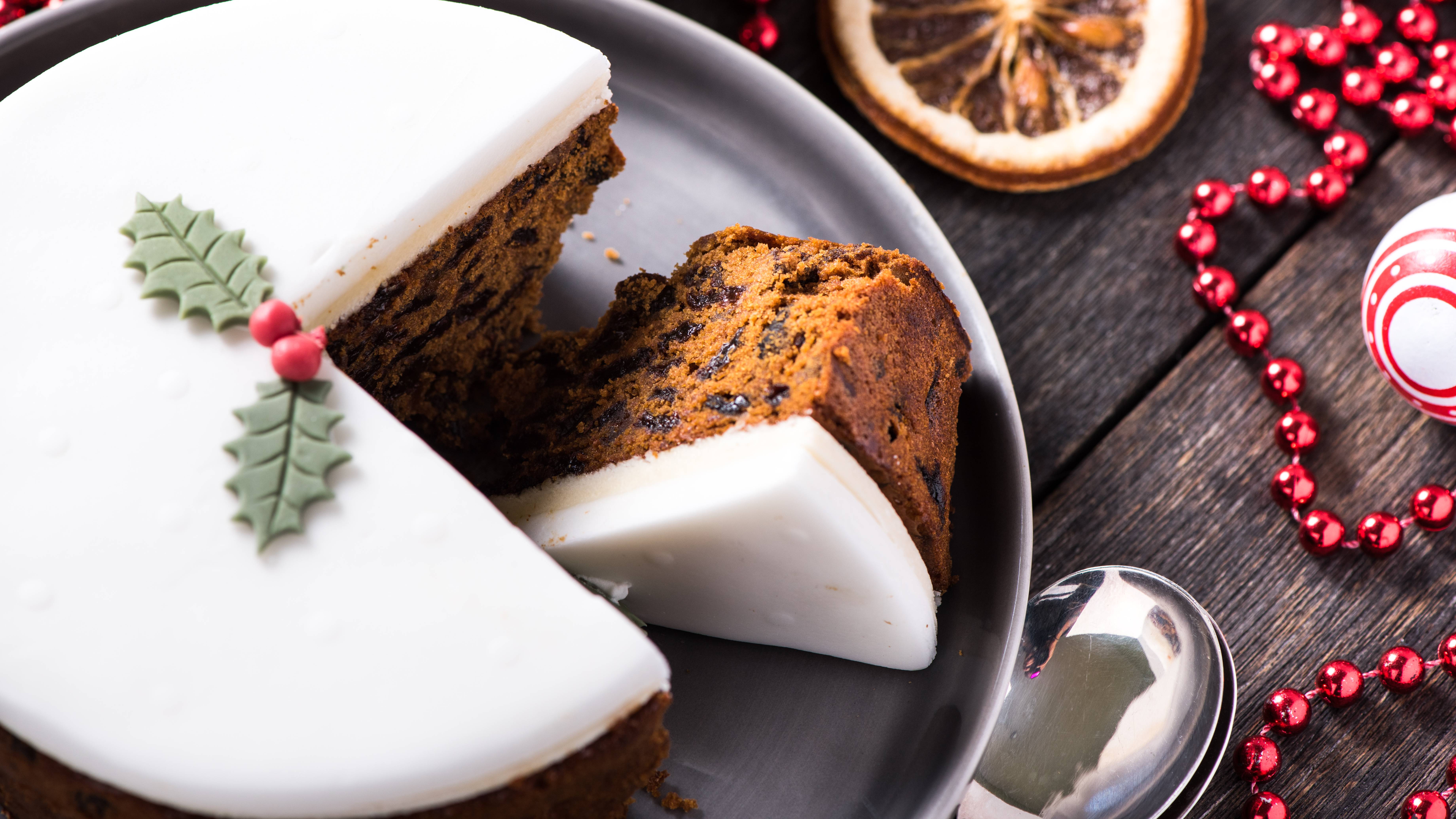This gluten free Christmas cake is just like a classic recipe but it uses gluten free flour and baking powder.
Full of festive spices, nuts and fruits, this cake is a great crowd pleaser and perfect if you’re hosting a group of people where some are gluten intolerant. This cake is delicious even without the use of regular plain flour and it’s quicker than most Christmas cake recipes which are traditionally baked at the end of November. You can bake this on Christmas day if you wanted to.. and you have the time of course!
Ingredients
- 350g mixed dried fruit
- 100ml brandy or orange juice
- 150g butter, softened
- 150g soft light brown sugar
- 3 eggs, beaten
- Zest of 1 large orange
- 50g blanched almonds, chopped
- 50g glace cherries, halved
- 2 tsp vanilla extract
- 150g gluten-free plain flour
- 1½ tsp gluten-free baking powder
- 2 tsp ground mixed spice
- 1 tsp ground ginger
- 100ml milk
For the icing:
- 5-6 tbsp apricot glaze or sieved apricot jam
- 750g white marzipan
- 1kg of packet white sugarpaste
WEIGHT CONVERTER
Method
- Put the dried fruit in a bowl with the brandy or orange juice and leave to soak for 2 hrs or overnight.
- When the fruit has soaked, heat the oven to 170C (150C fan, Gas 3). Grease an 18cm round deep cake tin and line the base and sides with a double thickness of baking paper.
- Put the butter and sugar in a large bowl and beat together until pale and creamy. Gradually beat in the eggs, adding a little of the flour if the mixture begins to curdle. Add the soaked fruit, orange zest, almonds, cherries and vanilla extract.
- Sift together the flour, baking powder and spices and fold into the mixture with the milk. Spoon the cake mixture into the prepared tin and level the surface.
- Bake for 1hr 30mins - 1hr 45 mins until golden, firm to the touch and a skewer inserted into the cake comes out clean. Cool in the tin for 15 mins then turn out onto a wire rack and leave to cool completely. Finally, ice your Christmas cake with apricot jam, white sugar paste and marzipan, if liked.
Top tips for making this gluten free Christmas cake
If you’d prefer a naked cake decoration, gently press some whole nuts and glace cherries into the top of the cake before baking. Brush with some warm apricot jam to glaze it before serving.
Why is my gluten-free Christmas cake crumbly?
Following the recipe above, you should find that this cake is not crumbly, but has a similarly moist and delicious texture to non-gluten-free recipes. This is because of the high fruit content, which keeps in moisture and acts almost like a binding agent.
Do not skip the overnight soak for the fruit, which adds in even more moisture, essential to the recipe. If you still find your GF bakes come out a little on the dry side, check the flour you are using. Not all gluten-free flours are created equal.
Find one that is specifically designed for cake baking. You could even use a blend of two different GF flours to get the benefits of both.
Should I ice the sides of my cake or just the top?
It's entirely up to you - icing adds a later of rampant sweetness to Christmas cake. Traditionally this counteracted some of the bitterness in the preserved fruit, but this cake is not bitter. If you prefer a slightly less sweetened cake, ice only the top - or leave the icing off completely and decorate with fruit and nuts.
Why do we put marzipan on Christmas cakes?
Traditionally marzipan seals the cake and traps the moisture inside it, leaving a dry, smooth outer finish for the icing to go on top of. The also ensures the icing does not leach the moisture out of the cake at the edges, and discolour.
Can I leave out the marzipan if I don't like it?
With this cake, you can. Traditionally Christmas cakes are made well in advance of Christmas - up to 3 months. The marzipan layer is usually added after the cake has been stored and fed for several weeks - about 14 days before Christmas.
It then has time to dry and harden before the cake is iced just before Christmas. However, this gluten-free cake does not need to be made so far in advance - in fact, it's best eaten within a couple of weeks of being made.
As such, you can simply ice the cake directly if you prefer. The icing will not be as smooth and you may find the icing begins to discolour a little after about a week or so, but if you dislike marzipan it's probably a fair trade-off.
Mary Berry's fruit cake is another great option if you're looking for something different. We'd also recommend our easy Christmas cake which takes just 15 minutes to prep. And for those of you looking for some Christmas cake decorating ideas, we have a whole range to choose from - including fondant Christmas trees and edible snowmen.
Did you know you can bake your Christmas cake in an air fryer? It's much quicker than using a conventional oven and bakes just as well.
Parenting advice, hot topics, best buys and family finance tips delivered straight to your inbox.
